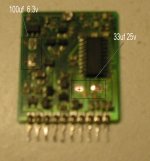Been having intermittent startup problems with my IIsi. That thing when the relay snaps off as soon as it comes on.
When it behaves, the whole system starts up with no symptoms. So I don't think there is any problem with the main circuits in the PSU or on the logic board. It all looks clean and logic board has just been recapped with tantalums, the 5v and 12v rail filters with low-ESR electrolytics.
I put an oscilloscope on the PSU outputs, with the PSU removed from chassis. The trickle current that is supposed to power the startup is on pin 10. On AC power-up, this pin takes about a second to rise from 0 to just under +5volts, the relay snaps on, then off, and the trickle returns to 0. End of story till next AC on.
The result is the same if I bridge pin 10 to ground, which some threads suggest should force the PSU to start up. I'm not so sure about that, because the case and keyboard power interrupt switches are both "normal on - instant off", which suggests that the power-on circuit is triggered by a ramp up rather than a steady on like the ATX "power good". Please correct me on this if you know more.
The PSU pins that are supposed to be GROUND are carrying about +.3volts as long as AC is on. Is that normal or does it suggest a possible diode leak?
Inside the PSU is a small PCB with one chip and a bunch of other components, including two electrolytic caps that look like the 220uf types I have just replaced on the logic board. Looks like that PCB may be what ramps up the trickle current. I'm suspicious of those caps.
Is there a schematic around for the Sony PSU? This is a 240vac model AP56 , part number 699-0567.
Any other thoughts on cause/cure?
Rick
When it behaves, the whole system starts up with no symptoms. So I don't think there is any problem with the main circuits in the PSU or on the logic board. It all looks clean and logic board has just been recapped with tantalums, the 5v and 12v rail filters with low-ESR electrolytics.
I put an oscilloscope on the PSU outputs, with the PSU removed from chassis. The trickle current that is supposed to power the startup is on pin 10. On AC power-up, this pin takes about a second to rise from 0 to just under +5volts, the relay snaps on, then off, and the trickle returns to 0. End of story till next AC on.
The result is the same if I bridge pin 10 to ground, which some threads suggest should force the PSU to start up. I'm not so sure about that, because the case and keyboard power interrupt switches are both "normal on - instant off", which suggests that the power-on circuit is triggered by a ramp up rather than a steady on like the ATX "power good". Please correct me on this if you know more.
The PSU pins that are supposed to be GROUND are carrying about +.3volts as long as AC is on. Is that normal or does it suggest a possible diode leak?
Inside the PSU is a small PCB with one chip and a bunch of other components, including two electrolytic caps that look like the 220uf types I have just replaced on the logic board. Looks like that PCB may be what ramps up the trickle current. I'm suspicious of those caps.
Is there a schematic around for the Sony PSU? This is a 240vac model AP56 , part number 699-0567.
Any other thoughts on cause/cure?
Rick

